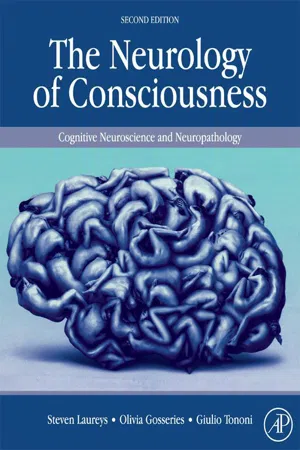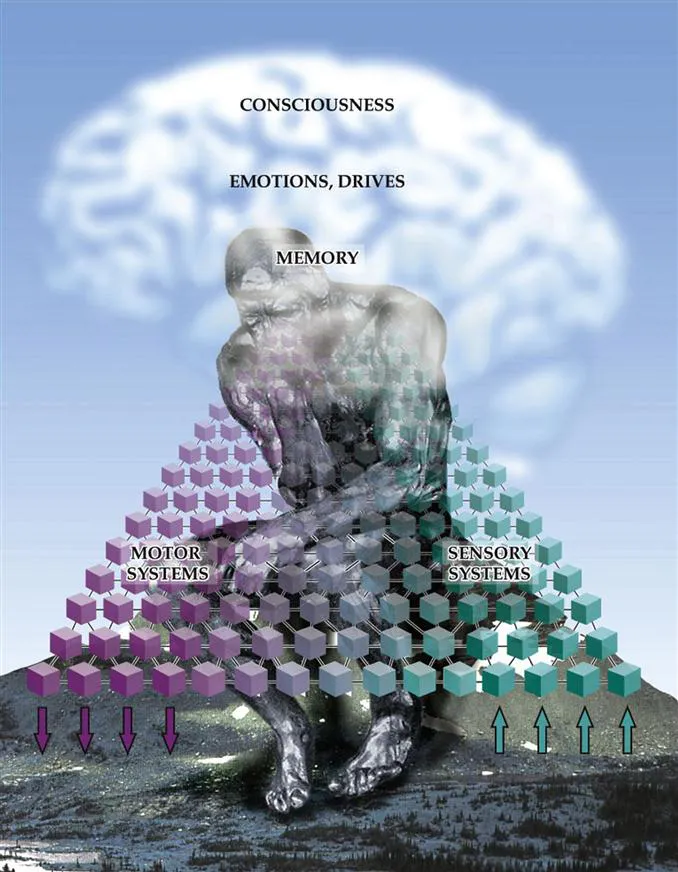
eBook - ePub
The Neurology of Consciousness
Cognitive Neuroscience and Neuropathology
- 488 pages
- English
- ePUB (mobile friendly)
- Available on iOS & Android
eBook - ePub
The Neurology of Consciousness
Cognitive Neuroscience and Neuropathology
About this book
The second edition of The Neurology of Consciousness is a comprehensive update of this ground-breaking work on human consciousness, the first book in this area to summarize the neuroanatomical and functional underpinnings of consciousness by emphasizing a lesional approach offered by the study of neurological patients. Since the publication of the first edition in 2009, new methodologies have made consciousness much more accessible scientifically, and, in particular, the study of disorders, disruptions, and disturbances of consciousness has added tremendously to our understanding of the biological basis of human consciousness. The publication of a new edition is both critical and timely for continued understanding of the field of consciousness.
In this critical and timely update, revised and new contributions by internationally renowned researchers—edited by the leaders in the field of consciousness research—provide a unique and comprehensive focus on human consciousness. The new edition of The Neurobiology of Consciousness will continue to be an indispensable resource for researchers and students working on the cognitive neuroscience of consciousness and related disorders, as well as for neuroscientists, psychologists, psychiatrists, and neurologists contemplating consciousness as one of the philosophical, ethical, sociological, political, and religious questions of our time.
- New chapters on the neuroanatomical basis of consciousness and short-term memory, and expanded coverage of comas and neuroethics, including the ethics of brain death
- The first comprehensive, authoritative collection to describe disorders of consciousness and how they are used to study and understand the neural correlates of conscious perception in humans.
- Includes both revised and new chapters from the top international researchers in the field, including Christof Koch, Marcus Raichle, Nicholas Schiff, Joseph Fins, and Michael Gazzaniga
Frequently asked questions
Yes, you can cancel anytime from the Subscription tab in your account settings on the Perlego website. Your subscription will stay active until the end of your current billing period. Learn how to cancel your subscription.
At the moment all of our mobile-responsive ePub books are available to download via the app. Most of our PDFs are also available to download and we're working on making the final remaining ones downloadable now. Learn more here.
Perlego offers two plans: Essential and Complete
- Essential is ideal for learners and professionals who enjoy exploring a wide range of subjects. Access the Essential Library with 800,000+ trusted titles and best-sellers across business, personal growth, and the humanities. Includes unlimited reading time and Standard Read Aloud voice.
- Complete: Perfect for advanced learners and researchers needing full, unrestricted access. Unlock 1.4M+ books across hundreds of subjects, including academic and specialized titles. The Complete Plan also includes advanced features like Premium Read Aloud and Research Assistant.
We are an online textbook subscription service, where you can get access to an entire online library for less than the price of a single book per month. With over 1 million books across 1000+ topics, we’ve got you covered! Learn more here.
Look out for the read-aloud symbol on your next book to see if you can listen to it. The read-aloud tool reads text aloud for you, highlighting the text as it is being read. You can pause it, speed it up and slow it down. Learn more here.
Yes! You can use the Perlego app on both iOS or Android devices to read anytime, anywhere — even offline. Perfect for commutes or when you’re on the go.
Please note we cannot support devices running on iOS 13 and Android 7 or earlier. Learn more about using the app.
Please note we cannot support devices running on iOS 13 and Android 7 or earlier. Learn more about using the app.
Yes, you can access The Neurology of Consciousness by Steven Laureys,Olivia Gosseries,Giulio Tononi in PDF and/or ePUB format, as well as other popular books in Psychology & Neurology. We have over one million books available in our catalogue for you to explore.
Information
Part I
Basics
Outline
Chapter 1
Neuroanatomical Basis of Consciousness
Hal Blumenfeld, Departments of Neurology, Neurobiology, and Neurosurgery, Yale University School of Medicine, New Haven, CT, USA
Neurology utilizes a localization-based approach that has firmly established the functional neuroanatomy of consciousness. Clinical disorders can either impair the specific contents of consciousness, such as language or visual processing; or can interfere with the overall level of consciousness. The specialized brain networks controlling the level of consciousness are called the “consciousness system,” and include cortical components, consisting mainly of bilateral frontoparietal association cortex, as well as subcortical components comprising multiple parallel arousal systems in the upper brainstem, thalamus, hypothalamus, and basal forebrain. Subcortical arousal systems include widespread projections acting through glutamate, gamma amino butyric acid, acetylcholine, epinephrine, dopamine, serotonin, histamine, and orexin. The bilateral higher-order heteromodal association cortex acts together with the subcortical components of the consciousness system to control the level of alertness, attention, and awareness. Cortical anatomy is also crucial for other aspects of consciousness including hemispheric specialization, emotional drive, feature binding, top-down, bottom-up, task-positive and task-negative (default mode) attention systems, voluntary action, self-awareness, and memory encoding for the report of conscious experience.
Keywords
Consciousness; neuroanatomy; association cortex; thalamus; brainstem; arousal; attention; ascending reticular activating system; frontal lobe; parietal lobe
Introduction
Consciousness is of great importance to normal human quality of life. The nature of consciousness and the best way to understand and define it have long generated lively debate among scientists, philosophers, clinicians, and the general public. From a neurological perspective, consciousness is classically described as emerging from brain systems that make up the content of consciousness, regulated by distinct systems that control the level of consciousness (Plum and Posner, 1982).
The content of consciousness is the substrate upon which levels of consciousness act. This content includes all the various types of information processed by hierarchically organized sensory, motor, emotional, and memory systems in the brain (Figure 1.1). Much of neuroscience is dedicated to understanding the normal functioning of these systems. Selective deficits in contents of consciousness, such as loss of a portion of one’s visual field, or sudden impairment in spoken language, are also the main subject matter of clinical neurology.

However, level of consciousness can affect all of these specific functions. The level of consciousness is controlled by specialized cortical and subcortical systems that determine the amount of alertness, attention, and awareness (mnemonic, AAA) (Blumenfeld, 2002). Basic alertness (arousal, wakefulness) is necessary for any meaningful responses to occur. Attention enables selective or sustained information to be processed. Finally, awareness is the ability to form experiences that can potentially be reported later. This chapter will review the neuroanatomical basis of brain systems that control the level of consciousness. In analogy with other cortical-subcortical systems such as the sensory, motor or limbic systems, the brain networks dedicated to regulating the level of consciousness can be referred to as the “consciousness system” (Blumenfeld, 2010, 2012). This chapter begins with an overview of the main cortical and subcortical structures that constitute the consciousness system. Next, the major subcortical networks that regulate level of consciousness are each discussed in turn, including the thalamus and subcortical arousal nuclei acting through multiple neurotransmitters (glutamate, acetylcholine, gamma amino butyric acid (GABA), norepinephrine, serotonin, dopamine, histamine, orexin) that arise from the upper brainstem, basal forebrain, and hypothalamus. The second half of the chapter reviews important cortical networks for controlling the level of alertness, attention, and awareness, including systems that select and encode conscious experiences into memories for subsequent report. This neuroanatomical review of the cortical and subcortical systems that control level of consciousness will serve as a general introduction to the normal functions as well as disorders of consciousness discussed in the remaining chapters in this book.
The Consciousness System
The specialized brain networks controlling the level of consciousness can be referred to as the “consciousness system” (Blumenfeld, 2009, 2010) (Figure 1.2). It has long been recognized through studies based on human brain disorders (Penfield, 1950; Plum and Posner, 1972; Von Economo, 1930) as well as experimental animal models (Bremer, 1955; Moruzzi and Magoun, 1949; Steriade and McCarley, 2010) that the level of consciousness depends critically on both cortical and subcortical structures. Here we provide a brief overview of the cortical and subcortical networks comprising the consciousness system, which will be discussed in greater detail in the remaining sections of the chapter.

Cortical components of the consciousness system include the major regions of the higher-order “heteromodal” (Mesulam, 2000) association cortex (Figure 1.2; see also Figure 1.11). On the medial brain surface, important components are the medial frontal, anterior cingulate, posterior cingulate, and medial parietal (precuneus, retrosplenial) cortex (Figure 1.2A). On the lateral surface, major consciousness system networks include the lateral frontal, anterior insula, orbital frontal, and lateral temporal-parietal association cortex (Figure 1.2B).
It is important to recognize that individual components of the higher-order association cortex play important and well-studied roles in specific cognitive functions in the dominant and non-dominant hemispheres as described in the behavioral neurology literature (Heilman and Valenstein, 2003; Mesulam, 2000). Recently these same association cortex regions have also been described as participating in either so-called task-positive networks based on their activation during externally oriented attention (Asplund et al., 2010; Buschman and Miller, 2007; Dosenbach et al., 2007; Vanhaudenhuyse et al., 2011) or task-negative networks, also known as the “default mode” based on activity at rest (Fox et al., 2005; Raichle et al., 2001). Regardless of the heterogeneous functions of individual regions or networks, it is the collective activity of widespread areas of bilateral association cortex that determines the level of consciousness. Taken as a whole, the higher-order association cortex interacts with subcortical arousal systems (Steriade and McCarley, 2010) to exert powerful control over the overall level of arousal, attention, and awareness.
Subcortical components of the consciousness system include the upper brainstem activating systems, thalamus, hypothalamus, and basal forebrain (Figure 1.2A). It is likely that other subcortical structures (not shown) also participate, including portions of the basal ganglia, cerebellum, amygdala, and claustrum. Multiple parallel neurotransmitter systems participate in subcorti...
Table of contents
- Cover image
- Title page
- Table of Contents
- Dedication
- Copyright
- Foreword
- Preface
- List of Contributors
- Part I: Basics
- Part II: Waking, Sleep, and Anaesthesia
- Part III: Severe Brain Injury and Related Conditions
- Part IV: Seizures, Splits, Neglects, and Assorted Disorders
- Index